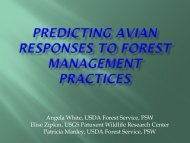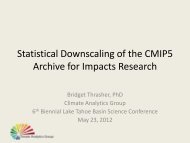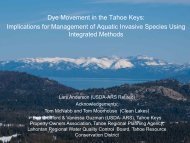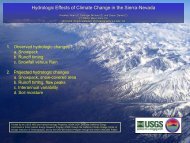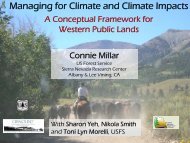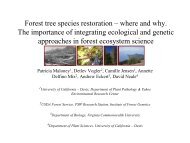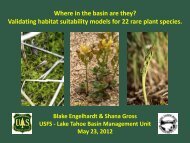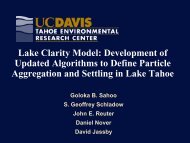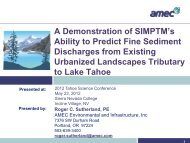Tarbill, Gina
Tarbill, Gina
Tarbill, Gina
- No tags were found...
You also want an ePaper? Increase the reach of your titles
YUMPU automatically turns print PDFs into web optimized ePapers that Google loves.
<strong>Gina</strong> <strong>Tarbill</strong>, USFS Pacific Southwest Research StationPatricia N. Manley, USFS Pacific Southwest Research StationT. Will Richardson, USFS Pacific Southwest Research StationWilliam Avery, Sacramento State University
Burn severityIsolation and extent of burned areaColonization abilityPhoto credit: John Briggs, birdinginmaine.comFacilitative actions of keystonespecies
Early colonizersCreate foragingareasPhoto credit: Tom Grey and US Forest ServiceMediateinsectpopulationsCreate habitatthrough cavityexcavation
• Depend on woodpeckersfor cavities• Diverse• Seed dispersers• Insectivores• Prey base• Raptors and smallcarnivores• Species of concern
Determine the influence ofwoodpeckers on colonization ofbirds and mammals in burnedforestDetermine factors influencingwoodpecker nest site selection inburned forest
Black-backed woodpecker Hairy woodpecker White-headed woodpeckerPicoides arcticus P. villosus P. albolarvatusPhoto credit: Ron Wolf, Birds of North America
ExcavatorNestsdiscoveredNestsmonitoredNests withdetectionBlack-backedWoodpeckerHairyWoodpeckerWhite-headedWoodpeckerTotals39 18 89%80 26 73%50 32 94%169 76 86%
Mean species richness1.81.61.41.210.80.60.40.20Black-backedWoodpecker(n=28)Hairy Woodpecker(n=26)White-headedWoodpecker(n=32)Significant difference in meanrank of species richness(Kruskal-Wallis, H 2 =7.10,p=0.03)Photo credit: T. Will Richardson
Black-backedWoodpeckerWhite-headedWoodpeckerHairy WoodpeckerProportion of use< 0.100.10- 0.49> 0.50NorthernFlyingSquirrelNorthernFlickerHouseWrenAmericanKestrelChipmunkMountainChickadeeWesternBluebirdMountainBluebirdWhitebreastedNuthatchDouglasSquirrel
260Shaded area is 95% confidence interval
Scorched, shorter,and highly decayedsnags in standswithout small treesSmallerdiameter lessdecayed snags instands with highdensity of smallsnagsScorched, lessdecayed snags instands withoutsmall trees
• White-headed and BlackbackedWoodpeckers exertedstrongest influence oncolonization• Cavities excavated by HairyWoodpecker were used leastrelative to their availability• Woodpecker species are notecologically equivalent inhabitat creationPhoto credit: T. Will Richardson
• Maintaining total secondarycavity community mayrequire all three woodpeckerspecies• Cavity availability may limitpopulation size of secondarycavity users• Influence of woodpeckersmay be ephemeral in burnedforest due to low snagpersistence and post fireharvest
• USDA Forest Service• Southern NevadaPublic LandsManagement Act• Department ofBiological Sciences atSacramento StateNaturepicsonline for photos
Aitken, K.E.H and Martin, K. (2007) The importance of excavators in hole-nesting communities: availability and use of natural tree holes in old mixed forests ofwestern Canada. Journal of Ornithology 148: S425-S434.Aubrey, K.B. and Raley, C.M. (2002) The pileated woodpecker as a keystone habitat modifier in the Pacific Northwest. General Technical Report. PSW-GTR-181.Pacific Southwest Research Station, Forest Service, U.S. Department of Agriculture.Bednarz, J.C., Ripper, D., and Radley, P.M. (2004) Emerging concepts and research directions in the study of cavity-nesting birds: keystone ecological processes. TheCondor 106:1-4.Blanc, L.A. and Walters, J.R. (2007) Cavity-nesting community webs as predictive tools: where do we go from here? Journal of Ornithology 148: S417-423.Connell, J.H. and R.O. Slatyer (1977) Mechanisms of Succession in Natural Communities and Their Role in Community Stability and Organization. AmericanNaturalist 111: 1119-1144.Dixon, R.D. and Saab, V.A. (2000) Black-backed Woodpecker (Picoides arcticus), The Birds of North America Online (A. Poole, Ed.). Ithaca: Cornell Lab ofOrnithology; Retrieved from the Birds of North America Online.Garrett, K.L., Raphael, M.G., and Dixon, R.D. (1996) White-headed Woodpecker (Picoides albolarvatus), The Birds of North America Online (A. Poole, Ed.). Ithaca:Cornell Lab of Ornithology; Retrieved from the Birds of North America Online.Jackson, J.A., Ouellet, H.R. and Jackson, B.J. (2002) Hairy Woodpecker (Picoides villosus), The Birds of North America Online (A. Poole, Ed.). Ithaca: Cornell Labof Ornithology; Retrieved from the Birds of North America Online.Kotliar, N.B., Hejl, S.J., Hutto, R.L., Saab, V.A., Melcher, C.P., and McFadzen, M.E. (2002) Effects of fire and post-fire salvage logging on avian communities inconifer dominated forests of the western United States. Studies in Avian Biology 25:49-64.Lawton, JH and Jones, CG. (1995) Linking species and ecosystems: organisms as ecosystem engineers. Pages 141-150 in Jones CG, Lawton JH, eds. Linking speciesand ecosystems. New York: Chapman and Hall.Martin, K. and Eadie, J.M. (1999) Nest webs: A community-wide approach to the management and conservation of cavity-nesting forest birds. Forest Ecology andManagement 115: 243-257.Martin, T.E. and Geupel, G.R. (1993) Nest-Monitoring Plots: Methods for Locating Nests and Monitoring Success. Journal of Field Ornithology 64:507-519.Martin, T.E., C. Paine, C. J. Conway, W. M. Hochachka, P. Allen, and W. Jenkins. (1997) BBIRD field protocol. Biological Resources Division, MontanaCooperative Research Unit, Missoula, MT.Otvos, I.S., (1970) Avian predation of the western pine beetle. In:Stark, R., Dahlsten, D. (Eds.), Studies of the Population Dynamics of the Western Pine Beetle,Dendroctonus brevicomis Leconte (Coleoptera: Scolytidae). University California Press, Berkeley, California, pp. 119–127.Paine, R.T. (1969) A Note on Trophic Complexity and Community Stability. The American Naturalist 103: 91-93.Saab, V.A., Dudley. J,, and Thompson, W.L. (2004) Factors influencing occupancy of nest cavities in recently burned forests. The Condor 106:20-36.Simberloff, D. (1998) Flagships, umbrellas, and keystones: is single species management passé in the landscape era. Biological Conservation 83: 247–257.
Cavity Utilization Index spp = utilization spp * proportion usedSpeciesWhite-headedwoodpeckerBlack-backedwoodpeckerUtilization sppProportion ofcavities usedCavityUtilizationIndex2.5 94% 2.351.89 89% 1.68Hairy woodpecker 1.58 73% 1.15Secondary cavity users preferred White-headed Woodpecker cavitiesover those excavated by other species (Fisher’s Exact Test, p=0.04)
Code Bark1 Tight,intactHeartwoodDecayMinorSapwoodDecayNone toincipientLimbsMostlyPresentTopBreakageMay bepresentBoleFormIntactTimeSinceDeath1-5 years2 50% looseor missingNone toadvancedNone toincipientSmalllimbsmissingMay bepresentIntact>5 years3 75%missingIncipient toadvancedNone to25%FewremainApprox.1/3Mostlyintact>5 years4 75%missingIncipient toadvanced25%+ FewremainApprox.1/3 to ½Losingform, soft>5 years5 75%+missingAdvancedto crumbly50%+advancedAbsentApprox.½+Formmostlylost>5 years
Nest tree Nest Site TerritorySpecies Tree/snag density Forest typeDBH Canopy cover ImperviousDecay class Coarse woody debris Burn severityScorch Burn severityHeightcavity height
Secondary avian cavity usersCommon Code Scientific NameNameBrown Creeper BRCR Certhia americanaEuropean EUST Sturnus vulgarisStarlingHouse Wren HOWR Troglodytes aedonMountainChickadeeMountainBluebirdPygmyNuthatchRed-breastedNuthatchMOCHMOBLPYNURBNUPoecile gambeliSialia currucoidesSitta pygmaeaSitta canadensisWhite-breasted WBNU Sitta carolinensisNuthatchTree Swallow TRES TachycinetabicolorWestern WEBL Sialia mexicanaBluebirdAmerican AMKE Falco sparveriuskestrelFlammulated FLOW Otus flammeolusowlWestern screech WSOW Otus kennicottiiowlSpotted owl SPOW Strix occidentalisBarred owl BAOW Strix variaNorthern NPOW Glaucidium gnomapygmy owlNorthern sawwhetowlNSWO Aegolius acadicus
Secondary mammalian cavity usersCode Scientific NameDouglas TADOSquirrelFlying GLSASquirrelWestern gray SCGRsquirrelYellow-pine TAAMchipmunkLeast TAMIchipmunkLong-eared TAQUchipmunkTamiasciurusdouglasiiGlaucomyssabrinusSciurus griseusTamias amoenusTamias minimusTamiasquadrimaculatusShadow TASE Tamias senexchipmunkLodgepole TASP Tamias speciosuschipmunkBushy-tailed NECI Neotoma cinereawoodratPorcupine ERDO ErethizondorsatumPine marten MAAM MartesamericanaShort-tailed MUER Mustela ermineaweaselLong-tailedweaselMUFR Mustela frenata
Secondary cavityuser“Preferred”WoodpeckerSCU habitatassociationsN. Flying squirrel Black-backed Mature tree stands 1House wren Black-backed Edge, low canopyclosure1Northern flicker Black-backed Low stand density1Chipmunk White-headed Substantialunderstory/canopyMountain chickadee White-headed
Influence of each woodpecker species on secondary cavityusers was represented by the Cavity Utilization Index:Utilization spp = average of(#breeding species*2) +#non-breeding species+(#taxonomic classes – 1)Cavity Utilization index spp = utilization spp * proportion ofcavities with detections



